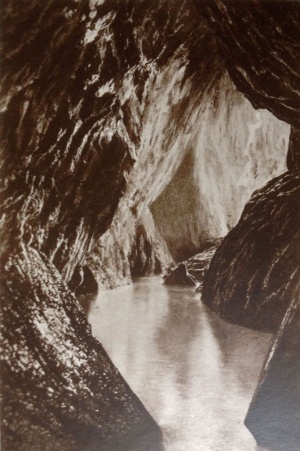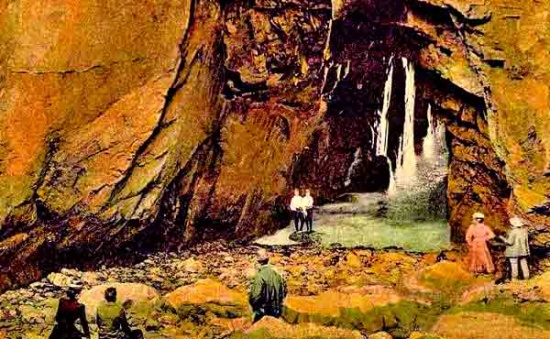Inhospitable coast
As far as the sailor was concerned, this stretch of the coast was probably the most inhospitable in the island. Over the millenia the elements have created a landscape of tiny coves and caves. Lacking any real landing place, its only saving grace was the shelter offered by the towering cliffs from the prevailing south westerly winds. It was this rocky grandeur that drew intrepid Victorian tourists in search of wild nature and caused a proliferation of romantic name changes.
At the eastern end of St John’s Bay stands La Tête de Frémont, which means ‘cold hill’ - the earliest reference to it dates from the middle of the twelfth century and appeared in its Latin form Frigidus Mons. In the Iron Age, about 2-2,500 years ago, a ditch was cut across the headland and the earth and rubble thrown up was used to form a bank four metres high, which would have been topped with a timber palisade. A simple causeway led to the defended gate which gave access to a secure enclosure or promontory fort.
An excavation in 1963 uncovered a few finds, but no internal buildings. This defensive function carried on over the centuries with the Legge report published in 1680 showing that there was guardhouse here, and 77 years later a map of the island prepared for the French Navy showed a battery of four cannon.
Beyond Frémont[1], at the base of the highest cliffs in the island, are Wolf Caves. This is one of the names - Les Grottes du Loup - invented to create an air of mystery and romance to entice the 19th century tourist. Corsetted Victorian ladies dressed in their ankle-length skirts, hats and stout leather shoes, accompanied by their menfolk clad in smart woollen suits, climbed down the snaking path to visit the caves.
Venus Pool
Where the path crossed flooded rock pools, one of them romantically named the Venus Pool, local men were stationed to respectfully carry the ladies across. This usually entailed hoisting the ladies behind their backs by placing their hands beneath the armpits and lifting. An iron ladder was removed by the occupying forces during the War.
A ‘hotel’ was convenienty located at the top of the cliffs to privide sustenance to the intrepid tourists once they had climbed back up the cliff path. Hotel is possibly a rather grand description for what was essentially a large pavillion with a corrugated iron roof. Built about 1870, it did a brisk trade, but the building was destroyed by fire during the Occupation. Following Liberation, a café was built on the site and this was developed into licensed premises in 1975, and enjoyed a further period of success in Jersey’s tourism heyday of the 70s and 80s. It finally closed its doors in 2001- probably killed off by its remote location, changes in attitude to drink driving laws and the changing holiday habits of the islands’s tourists.
Sailing westward across St John’s Bay, passing Les Salines, the salt pans where small amounts of salt were obtained by allowing small amounts of seawater to dry out, and Mourier Bay, beneath Les Fontaines – not to be confused with Mourier Valley further to the west - we finally come to the most northerly point of Jersey – Ronez. Taking its name from the old Norse words hraun and nes , the rocky headland, the name first appeared in 1309, when it was written down as 'Rokens'. During the Napoleonic wars there was a watch house here along with a semaphore station.
Quarrying
Quarrying in this part of St John really developed during the late 18th century, with the large capital developments in St Helier - Fort Regent and the Harbour. In the 1820s French stone workers came to the island to work at Ronez. As the quarry grew, a jetty was built to allow the stone to be shifted by sea; started in 1901 it was completed in 1903 at a cost of £1,000.
The first vessel to use the jetty was the German-owned ss Senator Kruger, which loaded 375-tons of quarried stone destined for London’s Surrey Docks. Berthing alongside was invariably a tricky operation because of the swell and mooring buoys were laid in order that vessels could be safely warped in.
During the Occupation the Germans worked the quarry to provide crushed granite for the concrete they used in all their fortifications. Much of the heavy work was carried out by Russian prisoners. A railway line was built to move the stone from the quarry to Pont Marquet, where it joined the re-activated St Helier-Corbiere line. The jetty was blown up and the crane toppled into the deep-water berth to prevent it being used by a potential enemy.
Export by sea was resumed by 1947 once the deep-water berth had been cleared and the jetty repaired. However, by 1978 the trade was over and the old jetty allowed to fall into disrepair.
To the west of Ronez lies La Houle, ‘the hollow in the cliffs’, and on the far side of the small bay beneath Sorel Point, lying about the half tide mark, is a large rectangular pool about seven or eight metres long and about five metres deep originally called Lé Pits d'la Tchuette. In the first half of the 19th century it was given the more romantically appealing name Lavoir des Dames – the fairies' bath - and had an instantly ancient legend attached to it – it was here that fairies were said to bathe naked and that if any mortal man should ever spy on them then he would be struck blind.
Just offshore is a reef known as Grune de Vicq - a grune is a rock that lies just beneath the surface of the water.
Sorel Point takes its name from the yellowish brown colour of the local granite. The small, free-standing lighthouse built here in 1938 is the most northerly navigation light on the island. It was orginally painted in a black and white check pattern but since 2009 it has been all white. According to legend it was from here that in 1565 stunned parents watched as their children drowned on their way to Sark when their boat was wrecked on the Paternosters. While the story is highly unlikely, the view from here over to the other islands is quite glorious.
The 1757 French Navy map, which was actually based on an English chart made two years earlier by Captain Clement Lempriere, showed that there was a gun battery armed with four cannon on the west side of Sorel, although with no decent landing place or anchorage in the vicinity, the question must be asked why would anyone bother to waste valuable cannon here?
Continuing westward across La Fosse Vicq, which probably means the deep inlet – from fosse meaning ‘deep water at the foot of a cliff' and the Norse placename vik which means an inlet or bay – rounding La Plaine Point brings us to the waterfall cascading over the cliff out of Le Mourier Valley.
This stream marks the boundary between St John and St Mary; it was fast flowing and powered at least three watermills. The one nearest the waterfall was a fulling mill; this was the process during which cloth was beaten and cleaned with fuller’s earth and water to shrink the loose fibres and create a denser fabric. In 1939 the stream was dammed to create a small reservoir, from which water was pumped up to the larger reservoir at Handois.
Beyond the waterfall and just before Devil’s Hole is Le Creux à la Congre - the hole of the conger. It was here that in 1851 that a French cutter called the Josephine came to grief in thick fog while on passage from Cherbourg to St Malo. One of the crew managed to swim ashore and climb the cliffs to raise the alarm, while the other four crewmen remained with the vessel. The owner of the Priory Inn, Nicholas Arthur, and another man were able to organise their rescue, for which they were awarded silver medals and certificates by the Minister of Marine in Paris. One of the things that was salvaged from the wreck was the figurehead.
Devil's Hole was originally named Le Creux de Vis or Le Creux de la Toureaille, roughly translated as ’the screw or spiral hole’. The name Devil’s Hole first made an appearance in 1885 - possibly the result of a mispronunciation of de vis for Devil. The site is actually a blow hole and at high tide the cave at the bottom of the cliffs floods, and water is forced through the cave/tunnel and out the back creating a booming noise. A guide book from 1881 described the cave as being 15-25 feet high and 80-90 yards long.
The original carved figure, which was placed at the bottom of the winding path, was a devil which had been adapted from the ship’s figurehead, which was washed up on the site in 1851 following the wreck of the Josephine.
The Devil figure remained for about a century until it was finally stolen around 1957. The current statue - the fourth – is made of metal.
The actual crater of Devil’s Hole is about 30-35 metres across and 60-70 metres deep.
The man who transformed the figurehead, which was also salvaged by Mr Arthur, was Jean Giffard of St Peter – better known as Turnkey Giffard, as he was also a prison warder and ex-seaman. Giffard was also responsible for the very ornate façade of the pub now known as the Lamplighter in Mulcaster Street, St Helier
Further reading
Notes and references
- ↑ The 430-foot mast which receives and transmits ITV programmes in the Channel Islands was erected here in 1962
| Previous | Next | |
| Bonne Nuit Bay | St John coast | St Mary coast |




